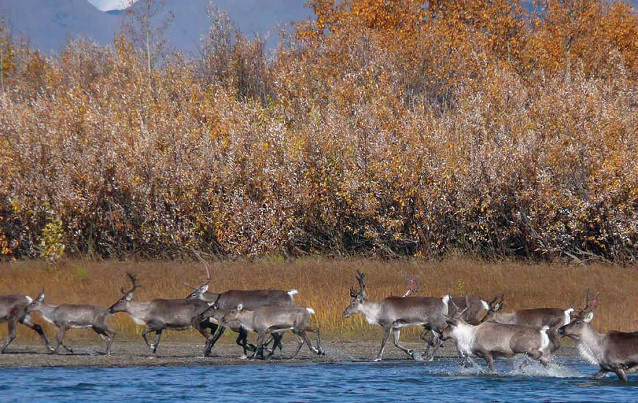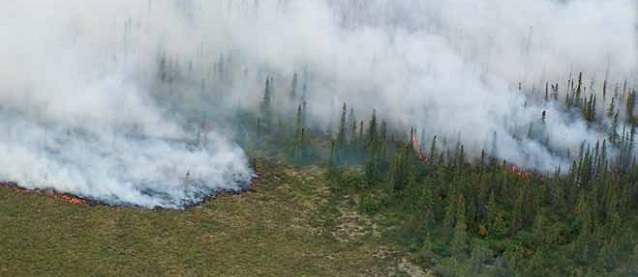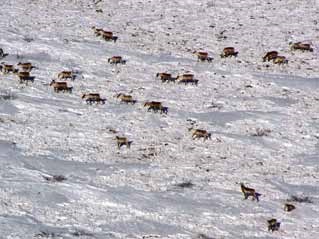
NPS photograph by K. Joly
Vast, migrating herds of caribou are an iconic image of the North. Yet, there is concern that a changing climate may drive this magnificent species the way of the Great Plains bison. The complexity that characterizes the ecology of caribou includes their extreme interconnectedness with other ecosystem components, including thousands of years of interactions with humans.
Numbers of caribou naturally oscillate in dramatic fashion on the time-scale of decades (Gunn 2003). Key influences driving population dynamics include climate, habitat, predation, parasites, insects and diseases, human influences, invasive species, competition, stochastic events, and the caribou themselves (Figure 1). The relative influence of each factor varies throughout the vast range of the genus Rangifer (both reindeer and caribou, hereafter referred to as caribou). Humans affect caribou through hunting, disturbance, industrial pollution, facilitating invasive species and reindeer grazing. While human influence is increasing in the Arctic, it is much greater in the southern areas of caribou distribution.
The southern extent is where populations have been extirpated and most endangered populations reside (Hebblewhite et al. 2010). Our goal is to explain, within the limits of our present understanding, how the changing climate can be expected to influence caribou populations through its affect on these primary influences.

Designed by L. Weaver
Climate, Stochastic Events, Parasites, Insects and Diseases
Climate is an ultimate driver influencing caribou population ecology by directly affecting growth, quantity and nutritional quality of forage plants forage; through its influence on insects that harass and parasitize caribou in summer; through its control over snow characteristics that determine forage accessibility in winter; and the vulnerability of caribou to predation. Subcomponents of the climate system, namely snow, icing, rain, solar input, temperature, wind, clouds, and seasonality, vary dramatically in their importance to the ecology of different caribou populations.
Snow is present during a major portion of the year within all caribou ranges. The greatest depths are in the temperate, moist mountainous regions of southwest Canada, and the lowest are in the polar deserts of the High Arctic. Greater snow depth increases the energy expended for movement and to reach winter forage species such as ground-dwelling lichens (Fancy and White 1985), which can contribute to poor body condition and greater vulnerability to predation. Snow can also influence the timing of green up, which may have serious nutritional and reproductive consequences. Deep snow years have been associated with poor physiological condition of cows in spring, lower calf birth weights, reduced calf survival, slower growth of surviving calves, poor body condition of calves entering winter, reduced pregnancy rates the following year, and delayed parturition the following spring (Adams et al. 2006).
Icing or rain on snow events that restrict forage access are more critical to northern populations of caribou, which are reliant upon ground-dwelling lichens in winter, in contrast to southern populations that rely primarily on arboreal lichens. Similarly, wind can be detrimental to caribou by hardening the snowpack, restricting access to winter forage (Fancy and White 1985) or increasing energy costs of thermoregulation for young caribou after calving or for all caribou during extreme cold. However, wind can blow snow clear making it easier to access forage and evade predation. In summer, windy locations are sought to reduce insect harassment. Rain can also directly affect thermoregulation in calves, influence growth of forage species, as well as the prevalence of wildfire upon the landscape (Duffy et al. 2005).

NPS photograph by K. Joly
The presence and extent of cloud cover, through its influence on solar insolation and temperatures at ground level, can affect caribou either directly or indirectly. Cloud cover in summer usually is associated with cool ambient temperatures, and thus, reduced activity of insects, especially mosquitoes, allowing for increased time available for optimal foraging by caribou (Moerschel and Klein 1997) and a prolonging of peak summer forage quality (Bø and Hjeljord 1991). Precipitation, temperature, winds and clouds can all be affected by large-scale, long-lived climate patterns, such as the Pacific Decadal Oscillation (Hartmann and Wendler 2005).
Seasonality, a function of climate, is the overriding annual variable influencing caribou ecosystem components. Quantity and quality of forage species are governed by the rate of summer growth, whereas in winter, snow depth and density conditions alter availability of forage. Variables in summer weather influence the intensity and duration of insect harassment. Fall is the period when caribou must replenish their energy and protein reserves before facing the long winter when protein-rich forage is limited. Fall body condition is a strong determinant of pregnancy rates (Cameron et al. 1993).

NPS photograph by K. Joly
Climatic conditions also strongly affect the distribu-tion and abundance of parasites, insects and diseases that exert varying levels of influence on caribou population dynamics. The importance of these influences decline with latitude. Increased movements, due to insect harassment, have been linked to reduced growth of caribou calves over summer (Couturier et al. 2009). A suite of diseases and parasites can negatively affect caribou body condition, influencing their ability to survive and reproduce, cause mortality or loss of the fetus.
Climate change is expected to modify current patterns of snow, icing, rain, temperature, wind, clouds, and seasonality within the range of caribou. Temperatures are predicted to increase under all climate change scenarios, raising a suite of problems for caribou. Warm-ing increases summer forage quantity but can reduce its quality (Callaghan et al. 2004), while quantity of lichens is reduced (Joly et al. 2009). Conversely, caribou will presumably benefit from shorter winters, with lower energy costs for winter activities and body maintenance. Warmer winters may allow for greater in-season snow melt, which also may be beneficial for caribou (Tyler et al. 2008). Dryer conditions in summer are expected to result in increased prevalence of wildfire (Duffy et al. 2005). Caribou are known to avoid burned winter habitat for decades, both in the tundra and boreal forest, (Joly et al. 2007) likely due to the destruction of forage lichens, which can take up to a century or more to recover. Thus, fire can influence the nutrition and movements of caribou and in turn affect their population dynamics. Even small increases in temperature and growing season will dramatically increase the abundance, global distribu-tion and impacts of parasites, insects and diseases.
Variation in other climate subcomponents due to climate change cannot be reliably predicted at this point. Given the extent of predicted warming, drier conditions are expected to occur even if precipitation does increase. Significant signs of drying (e.g., declines in vegetative pro-ductivity) in the boreal forest have already been detected (Verbyla 2008). Increased summer winds could help reduce insect harassment in summer or scour snow from elevated terrain exposing forage plants in winter, and thus be beneficial to caribou. Increased wind can act to harden snow, which would be detrimental to caribou. Increased clouds reduces vegetative productivity, but would extend the length of peak nutritional quality of some forage species (Bø and Hjeljord 1991), which would be beneficial for caribou. Earlier spring green up and access to highly digestible forage may or may not benefit caribou. Stochastic events, such as avalanches and drownings (due to flood conditions or thin ice), will have varying degrees of influence but will likely be greater on smaller herds. Stochastic events, such as flooding, drought and extreme storms, are predicted to increase under climate change scenarios, which would be detrimental to caribou.

NPS photograph by K. Joly
Habitat, Human Influences, Density-dependent Factors and Competition
Habitat, encompassing areal extent, topography, vegetation, forage quantity, forage quality and forage availability, is a key influence on the population ecology of all species. Total available habitat can be an important and obvious influence on population dynamics where density of humans is high. Topography affects vegetation as well as precipitation, wind, temperature and phenology, and thus plays an important role in caribou ecology. Vegetation is crucial because caribou must travel through, exist in and also consume it to survive. Caribou generally avoid dense brush because it is difficult to travel through, to detect predators in, and are low in forage quantity and quality in winter. Deciduous forests are avoided in winter for similar reasons. Forage quantity is critical for obvious reasons; if any animal cannot obtain sufficient forage they will fail to reproduce and/or die. While more subtle, forage quality is extremely important to nutrition, affecting birth weights, survival, growth, pregnancy rates, timing of primiparity, timing of parturition, and body condition in general (Parker et al. 2009). Spring and early summer are the most nutritionally demanding periods for female caribou as they deal with reduced body condition from winter, the demands of a growing fetus and, after birth, lactation. Accessing high quality forage during the summer is important for body and antler growth, pelage replacement, and rebuilding nutrient stores for the upcoming winter. Lichens, because they provide a major source of energy that minimizes the need to catabolize body reserves, constitute a large proportion of the winter diet of migratory caribou that face predation. Forage availability is also important for obvious reasons; quantity and quality of forage are irrelevant if forage is not available. Typically, forage availability is limited by snow conditions. Caribou must balance foraging requirements with risk of predation throughout most of their range.
Caribou can exert density-dependent influences on their own population dynamics through grazing, trampling, disease transmission, and competition with each other. As caribou populations grow to relatively high numbers, they have the potential to reduce the overall quantity of food that is available to them – sometimes referred to as overgrazing or exceeding ‘carrying capac-ity’. By reducing the quantity of food available, nutritional condition can be reduced. Herd sizes are small in the southern and polar regions, thus these areas should be under less influence of density-dependent influences.
It has been shown repeatedly that caribou avoid areas affected by human created noise and activity (e.g., Johnson et al. 2005), which can displace parturient caribou from preferred calving ground, lower calf recruitment or reduce body condition due to increased energy expenditures to avoid the perceived disturbance. Industrial pollution, which can reduce the quantity and quality of forage available over large areas (Klein and Vlasova 1991), is more likely to affect populations in countries with more lax environmental regulations. This can lead to decreased body condition through the uptake of lower quality forage or by requiring caribou to increase movement to find unaffected areas. Both invasive flora and fauna have the potential to be detrimental. For example, the parasitic brain worm carried by white-tailed deer invaded habitats further and further north to the detriment of caribou as forests were cleared. Reindeer grazing could potentially affect wild caribou populations by deleterious gene flow, disease transmission, reduction forage availability on shared ranges.
Caribou habitat is likely to see dramatic changes over time due to changes in climate and human land use patterns. Patch sizes are likely to decrease for many populations. Caribou habitat will continue to be converted for human development and degraded by logging, which has hastened the decline of woodland caribou in Canada. Rising ocean levels due to melting glaciers will also reduce available habitat in low lying areas (e.g., Alaska’s coastal plain), but may actually increase it in areas currently covered in ice (e.g., Greenland). Climate change is likely to induce substantial changes to vegeta-tion throughout the distribution of caribou. It has been predicted that 50% of the tundra biome globally could be colonized by trees by 2100 (Callaghan et al. 2004). Tundra habitats are very important for caribou (Klein 1970), and its decline will likely be detrimental to caribou.
Interspecific competition has the greatest potential to influence caribou populations in the southern regions where ungulate biomass and diversity is the greatest. In the northern regions, physiological and behavioral differences between potential competitors (e.g., muskox, snowshoe hares, Dall’s sheep) have limited the relevance of competition (Klein 1996). Climate warming and increased human disturbance should make the landscape more favorable to species utilizing early seral stages, such as deer, elk and moose, increasing potential interspecific competition.
The expansion of shrubs into tundra habitat has already been documented and is expected to increase (Tape et al. 2006). Extensive summer foraging by caribou has the potential to retard shrub expansion in the Arctic (Post et al. 2009). However, substantial drying and/or increased fires could allow for entirely novel biomes to replace current caribou habitat (Rupp et al. 2000). In total, there is likely to be significantly less caribou habitat overall.

NPS photograph by K. Joly
Predation
The influence of predation on caribou populations varies depending on location, from virtually non-existent (e.g., Svalbard) to very important. Predators, including wolves, bears, wolverines, coyotes, eagles and humans, have greater potential to influence the population dynamics of small herds relative to large herds. Predation will exert more influence where alternative prey exists (Dale et al. 1994). Alternative prey biomass is greater in southern regions of caribou range, thus the influence of predation should be more important in that region.
Predation of calves is high in many locales, with bears often taking the most during the first few weeks following calving, and wolves after that. Predation by other animals tends to be focused on very young, very old, and debilitated caribou; however, predators are capable of killing healthy adult animals. In years where snow conditions tip the balance in favor of wolves, the focus on weaker animals is lessened (Ripple et al. 2001). Predation is thought to be capable of regulating caribou populations, especially at lower population numbers and densities. This regulation takes place through lowering recruitment of calves into the population, but in very small populations the mortality of adult females has been implicated.
Human predation, on the other hand, tends to focus on healthy, mature caribou. Sport hunters generally take bulls, while subsistence hunters take both males and females. Hunting pressure has been shown to influence the size, speed and age of first reproduction in ungulate populations. Human harvest from some populations is likely compensated for because the caribou might have died due to other causes. Much of the human harvest, however, is additive, because hunters tend to select larger healthier animals less subject to predation, accidents, and other “natural” causes of mortality. As a consequence, human predation can have significant impacts on caribou population dynamics. The main mechanisms for this in-fluence (besides the actual numeric reduction of animals) are the loss of the most productive and resilient age-sex classes and, in extreme cases, sex ratios can be reduced to a point so low that it can affect pregnancy rates.
Predation is likely to be increasingly important under climate warming scenarios and expanding human development within caribou range. Predators utilize human-created linear features to increase their efficiency in stalking prey. Smaller caribou populations are more easily regulated by predators. Human land use patterns also make the landscape favorable to species utilizing early seral stages, such as deer, elk and moose, and making caribou more vulnerable via habitat fragmentation.
Conclusion
The relatively rapid changes in climate we are experiencing today are difficult to model; however, a warmer and drier landscape is predicted over wide swaths of the current distribution of caribou. Extreme weather events are predicted to be more frequent and may test the resilience of caribou. Their adaptability has allowed caribou to survive previous radical changes in climate but has entailed major population fluctuations, as well as localized extinctions (Klein 1999). While some climate-induced changes will likely be of benefit to caribou, there is a fine line between benefits and when these changes become large enough that they become detrimental (Tyler et al. 2008). Major shifts in biome distribution will have the largest impact on caribou by altering habitat that may enable other ungulates, such as moose, and their predators to increase. These changes will also likely encourage humans to expand their footprint within caribou range. These changes will likely overshadow the effects of other population drivers if the rate of these expected changes exceed the ability of caribou to adapt. Consequently, we should expect dramatic reductions in caribou distribution and populations globally.
References
Last updated: November 1, 2022
